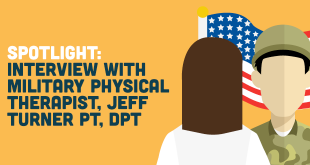You chose physical therapy over vet school, but you love animals all the same?
Just like their human counterparts, animals can develop functional limitations and mobility impairments as they age. Therefore, animals will also benefit from a skillfully developed plan of care for rehabilitation to address these issues. An animal rehabilitation therapist is just the person for the job.
Animal rehabilitation is a growing niche field – so much so that the APTA’s Orthopaedic Section has a Special Interest Group dedicated to it! The World Confederation of Physical Therapy also established a subgroup for PTs in Animal Practice in 2011. As the field expands, physical therapists have more and more opportunities to become involved with animal rehabilitation.
How did animal rehabilitation start?
The veterinary community has long recognized the benefits of physical therapy for animals, but its clinical application and relevance here in the United States is still in its infancy. Among the earliest recorded pioneers of animal rehabilitation was Sir Charles Strong, a European neighbor who published a book on Equine Physiotherapy in the mid-1960’s. As equine sporting events grew in popularity, so did associated racehorse injuries. Thus, horses may have been one of the first 4-legged species to publicly benefit from physical therapy!
By the 1980’s, canine rehabilitation was well known in Europe and by the 1990’s, the U.S. started to take notice. The first canine rehabilitation certificate program was started soon after the American Veterinary Medical Association added “animal physical therapy” to its guidelines in 1996.
Much like human medicine, veterinary medicine is seeing a shift in practice to more preventative care versus curative and palliative care. In 2003, the Canine Rehabilitation Institute, established by veterinarian Dr. Janet Van Dyke, welcomed its first set of students with the vision and foresight to prepare professionals with tools and knowledge to treat our animal companions.
Similarly, the University of Tennessee established a slew of higher education programs for canine and equine rehabilitation. These programs are offered to veterinarians/vet technicians, as well as PTs/PTAs and OTs/OTAs.
How do you become an animal rehabilitation therapist?
As of today, our canine companions have most of the spotlight when it comes to animal rehabilitation. There are two places where you can become certified in canine rehabilitation: The Canine Rehabilitation Institute (CRI) and the University of Tennessee (UoT).
At CRI, you will be working towards the Canine Rehabilitation Therapist Certification (CCRT) and you must have your physical therapy license to qualify for enrollment. At UoT, the Canine Rehabilitation Certificate Program (CCRP) is offered to both PTs, PTAs, and students of those disciplines.
UoT also has certification programs for equine rehabilitation, equine taping, canine fitness training, canine osteoarthritis case management, canine pain management, and nutrition case management. Both centers have been approved by the American Association of Veterinary State Boards Registry of Approved Continuing Education.
Both the CRI and UoT websites offer fairly comprehensive descriptions of the length and cost of their courses, but here’s a table for a quick comparison:
What’s it like being a canine PT?
Most animal rehabilitation therapists work alongside veterinarians and veterinary technicians in a clinic-based setting. To gain more knowledge about the life of an animal PT, I went straight to the source and interviewed Francisco Maia, PT, DPT, CCRT, also known as TheK9PT.
Francisco earned his certification in 2015 and has been working full-time since then as a Chicago-based canine therapist. He has created a fantastic website detailing the ins and outs of what it’s like to work with our canine friends on a daily basis.
Francisco also offered some practical insights for those interested in pursuing canine rehab:
- If possible, shadow someone who already works in the field to learn more about animal rehab before making such a large financial investment and time commitment.
- Experience with dog handling and behavior is a must to keep you safe. It will also teach you how to get the most out of your patients.
- Understanding animal behavior and handling is part of what makes a successful animal rehabilitation therapist. The rehab concepts are more or less the same as human physical therapy – you just need to learn how to integrate animal anatomy and physiology with your physical therapy knowledge.
- A successful animal rehabilitation therapist needs to know how to educate the family/owner about diagnosis, rehab programs, prognosis, and HEP. Don’t think you are done dealing with humans just because you are doing animal rehab!
- Look carefully at your physical therapy state act as it can vary a lot from state to state in terms of how you can practice.
To further connect with Francisco, you can visit his public pages:
Website: https://thek9pt.com/
Facebook: https://www.facebook.com/theK9PT/
Instagram: https://www.instagram.com/thek9pt/
Though I love canines, what about our other animal friends?
Well, that’s the exciting part.
It can begin with YOU! Canine and equine physical therapy are just the beginning of animal rehab. Don’t hesitate to further the conversation and build your own realm of expertise with a group of like-minded individuals!
For now, it seems that getting certified in canine rehabilitation is a good place to start. However, there are countless animal populations that would reap many benefits from rehab (have you seen the turtle on wheelies yet?). Plenty of therapists have further applied their canine rehab knowledge to treat our similarly aging and/or post-surgical feline friends. Additionally, animals like bunnies will have conditions like torticollis and splay leg. Other special-needs animals may have neurological impairments or may require limb amputations.
The conditions most frequently treated in cats are:
- Osteoarthritis (poor kittehs!)
- Post-traumatic injuries (OMG, poor, poor kittehs!)
- Obesity (probably from over-indulgent owners over-feeding cats…guilty as charged!)
Treatments that are most often administered to cats include:
- Stretching and manual therapy
- Range of motion
- Massage/STM
- Therapeutic exercise
- Proprioceptive activities
- E-stim/laser/ultrasound
- Aquatic therapy (believe it!)
Here’s where I found this awesome info!
The opportunities within animal rehabilitation are endless. Go after your animal rehab passions and improve the lives of our earth-sharing companions!
Are you an animal rehabilitation therapist or are you interested in seeing the field develop? Comment below and share your story. We would love to hear from you.
References
APTA: Orthopaedic Section SIG Animal Rehabilitation
Canine Rehabilitation Institute: http://www.caninerehabinstitute.com/
Today’s Veterinary Technician: http://todaysveterinarytechnician.com/articles/feline-physical-rehabilitation/
The University of Tennessee: http://www.utvetce.com/
World Confederation of Physical Therapy: PTs in Animal Practice
 NewGradPhysicalTherapy.com The Largest Online Resource For New Grad Physical Therapists
NewGradPhysicalTherapy.com The Largest Online Resource For New Grad Physical Therapists








